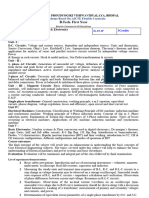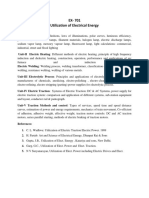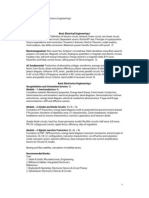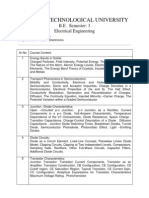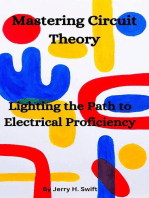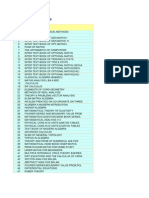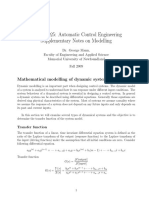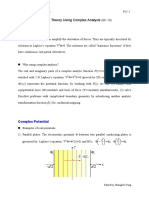Iii Ee - Sy - 260711061242
Iii Ee - Sy - 260711061242
Uploaded by
belikesourabhCopyright:
Available Formats
Iii Ee - Sy - 260711061242
Iii Ee - Sy - 260711061242
Uploaded by
belikesourabhOriginal Description:
Original Title
Copyright
Available Formats
Share this document
Did you find this document useful?
Is this content inappropriate?
Copyright:
Available Formats
Iii Ee - Sy - 260711061242
Iii Ee - Sy - 260711061242
Uploaded by
belikesourabhCopyright:
Available Formats
B.E.
301 - ENGINEERING MATHEMATICS II Unit I Fourier Series: Introduction of Fourier series , Fourier series for Discontinuous functions, Fourier series for even and odd function, Half range series Fourier Transform: Definition and properties of Fourier transform, Sine and Cosine transform. Unit II Laplace Transform: Introduction of Laplace Transform, Laplace Transform of elementary functions, properties of Laplace Transform, Change of scale property, second shifting property, Laplace transform of the derivative, Inverse Laplace transform & its properties, Convolution theorem, Applications of L.T. to solve the ordinary differential equations Unit III Second Order linear differential equation with variable coefficients : Methods one integral is known, removal of first derivative, changing of independent variable and variation of parameter, Solution by Series Method Unit IV Linear and Non Linear partial differential equation of first order: Formulation of partial differential equations, solution of equation by direct integration, Lagranges Linear equation, charpits method. Linear partial differential equation of second and higher order: Linear homogeneous and Non homogeneous partial diff. equation of nth order with constant coefficients. Separation of variable method for the solution of wave and heat equations Unit V Vector Calculus: Differentiation of vectors, scalar and vector point function, geometrical meaning of Gradient, unit normal vector and directional derivative, physical interpretation of divergence and Curl. Line integral, surface integral and volume integral, Greens, Stokes and Gauss divergence theorem References (i) (ii) (iii) (iv) (v) Advanced Engineering Mathematics by Erwin Kreyszig, Wiley India Higher Engineering Mathematics by BS Grewal, Khanna Publication Advance Engineering Mathematics by D.G.Guffy Mathematics for Engineers by S.Arumungam, SCITECH Publuication Engineering Mathematics by S S Sastri. P.H.I.
EE- 302 Electrical Engg. Materials
Unit I Conducting Material: Classification and main properties, High resistivity alloy: Constant Mangann,Nichrome, Electrochemical, properties of copper, Aluminum, steel tungsten, Molybdenum, Platinum, Tantalum, Niobium, Mercurry, Nickel, Titanum, Carbon, Lead, thermal, Bitmetals, thermocouple,materials, specific resistance, conductance, variation of resistance with temperature, super conductors. Unit II Semi Conductor Materials: General conception, variation of electrical conductivity, Elements having semiconductor properties, general application, hall effect, energy levels, conduction in semiconductors, Intrinsic conduction, impurity conduction, P and N type impurities, electrical change, Neutrality, Drift, Mobility current flow in semi conductors P-N junction formation by alloying, Elasing (forward and reverse) of P-n junction, Reverse separation current, Zener effect, Junction, capacitance, hall defects and hall coeffiecient. Unit III Magnetic Materials: Details of magnetic materials, reduction between B.H. and , soft and hard magnetic materials. Di-magnetic, Para magnetic and Ferromagnetic materials, electrical sheet steel, cast iron. Permanent magnetic materials. Dynamic and static hysteresis loop. Hysterisis loss, eddy current loss, Magnetisation, magnetic susceptibility, coercive force, core temperature, rectangular hysteresia loop, Magnet rest square loop core materials, iron silicon, Iron alloys. Unit IV Insulating Materials: General electrical mechanical and chemical properties of insulating material, Electrical characteristics volume and surface resistivity complex permitivity loss, and dielectric loss, equivalent circuits of an imperfect dielectric polarization and polarisability classification of dielectric. Unit V Mechanical Properties: Classification insulating materials on the basis of temperature rise. General properties of transformer oil, commonly used varnishes, solidifying insulating materials, resins, bituminous waxes, drying oils, Fibrous insulating materials, wood, paper and cardboard, insulating textiles, varnished adhesive tapes, inorganic fibrous material and other insulating materials, such as mica, ceramic, bakelite, ebonite, glass, PVC, rubber, other plastic molded materials. References: 1. TTTI Madras; Electrical Engineering Materials; TMH. 2. Electrical Engineering Material s & Devices; John Allison ;TMH 3. Materials for Electrical Engineering: B.M. Tareev 4. Anderson; Di-Electrics : 5. Kortisky; Electrical Engineering Materials: 6. Indulkar and S. Thruvengadem; Electrical Engineering Materials; S. Chand 7. Dekkor AK; Electrical Engineering Materials; PHI.
EE - 303 Electrical Instrumentation
Unit I Measurement and error, Accuracy and precision, sensitivity resolution, Error & Error analysis, Effect of temperature, Internal friction, Stray field, Hysterisis and Frequency variation & method of minimizing them, Loading effects, due to shunt connected and series connect ed instruments, calibration curve, Testing & calibration of instruments. Galvanometers Theory & operation of ballistic galvanometer, Darsonal galvanometer, galvanometer motion & damping, Sensitivity, Flux meter, Vibration galvanometer, Spot deflection galvanometer. Definition of analog & digital instruments, Classification of analog instruments, their operating principle, Operating force, Types of supports, Damping, Controlling. Unit II Different types of Ammeter & Voltmeter PMMC, MI, Electrodynamometer, Hotwire, Electrostatic, Induction, Rectifier, Ferro dynamic & Electro-thermic, Expression for control & deflection torque, their advantages, disadvantages & error, Extension of range of instruments using shunt & multiplier. Unit III Instrument transformers: Potential and current transformers, ratio and phase angle errors, testing of instrument transformers, Difference between CT and PT, errors and reduction of errors. Measurement of power: Power in AC and DC Circuit, Electrodynamometer type of wattmeter, Construction, theory, operation & error, Low power factor & UPF wattmeter, Double element and three element dynamometer wattmeter, Measurement of power in three phase circuit, one, two & three wattmeter method, Measurement of reactive power by single wattmeter, Measurement of power using CTs & PTs. Unit IV Measurement of Energy: Single phase induction type energy meter construction & operation driving and braking torques errors & compensations Testing by phantom loading and using R.S.S. meter- Three phase energy meter Tri-vector meter Maximum demand meter, Ampere hour meter. Potentiometer DC potentiometer standardization Lab type Cromptons potentiometer, application of DC potentiometer, AC polar type and coordinate type potentiometer, their construction and applications. Unit V Miscellaneous Instruments & Measurements: Power factor meter, Single phase and three phase Electro-dynamometer type & moving iron type. Frequency meter Vibrating reed, Resonance type & Weston type, Synchronoscope, Ohmmeter series & stunt type, Multi-meter, Megger & Ratio meter. Resistance Measurement Classification of low, medium & high resistance Voltmeter, Ammeter, Wheatstone Bridge, Kelvins double bridge & loss of charge methods for resistance measurement, Earth resistance measurement. Magnetic Measurement B-H Curve, Hysterisis Loop determination, Power loss in sheet metal Lloyd Fischer square for measurement of power loss. References: 1. E W Golding & F C Widdis; Electrical Measurement & Measuring Instruments; Wheeler Pub. 2. A.K. Sawhney; Electrical & Electronic Measurements & Instrument; Dhanpat Rai & Sons Pub. 3. Buckingham & Price; Electrical Measurements; Prentice Hall
List of experiments (Expandable): 1. Measurement of low resistance using Kelvins Double bridge 2. Measurement of medium resistance using Wheatstones bridge 3. Measurement of high resistance by loss of charge method 4. Measurement of Insulation resistance using Megger 5. Measurement of earth resistance by fall of potential method and verification by using earth tester 6. Measurement of power in a single phase ac circuit by 3 voltmeter/ 3 Ammeter method 7. Calibration of a dynamometer type of wattmeter with respect to a standard/Sub Standard wattmeter 8. Calibration of a induction type single phase energy meter 9. Calibration of a dynamometer type of wattmeter by Phantom Loading method 10. Measurements using Instrument Transformers 11. Study of various types of Indicating Instruments 12. Measurement of Power in three phase circuit by one, two & three wattmeters.
EE - 304 Semiconductor Devices and circuits
Unit I Semiconductor device, theory of P-N junction, temperature dependence and break down characteristics, junction capacitances, Zener diode, Varactor diode, PIN diode, LED, Photo diode, Transistors BJT, FET, MOSFET, types, working principal, characteristics, and region of operation, load line biasing methods,. transistor as an amplifier, gain, bandwidth, frequency response, Various applications of diode and special diodes. UNIT II Small signal analysis of transistor (low frequency) using h-parameters, thermal runaway and thermal stability. Unit III Feedback amplifier, negative feedback, voltage-series, voltage shunt ,current series and current shunt feedback , Sinusoidal oscillators, L-C (Hartley-Colpitts) oscillators, RC phase shift, Wien bridge, and Crystal oscillators. Power amplifiers, class A, class B , class A B, C amplifiers , their efficiency and power Dissipation, Pushpull and complimentary pushpull amplifier. Unit IV Switching characteristics of diode and transistor, turn ON, OFF time, reverse recovery time , transistor as switch , Multivibrators, Bistable, Monostable, Astable multivibrators. Cllipers and clampers, Differential amplifier, calculation of differential , common mode gain and CMRR using hparameters, Darlington pair , Boot strapping technique. Cascade and cascade amplifier. Unit V Operational amplifier characteristics, slew rate , bandwidth, offset voltage ,basic current, application ,inverting , non inverting amplifier , summer , average, differentiator, integrator, differential amplifier , instrumentation amplifier , log and antilog amplifier , voltage to current and current to voltage converters , comparators Schmitt trigger , active filters, 555 timer and its application. References: 1. Nashelsky & Boysted; Electronic Devices and Circuits; PHI 2. Millman Halkias; Electronic Devices and Circuits; McGraw- Hill 3. Achuthan MA and Bhatt KN; Fundamentals of semiconductor devices; TMH 4. Neamen Donald; Semiconductor Physics and devices 5. Millman & Grabel; Micro Electronics; McGraw-Hill 6. Bogart; Electronic Devices and Circuits; Universal Book Stall, NDelhi 7. Millman & Halkias; Integrated Electronics; McGraw- Hill. 8. Tobbey; OP- Amps their design and Application 9. R.A. Gaikward; OP- Amp and linear Integreted circuit; PHI 10. D. Raychowdhary and Shail Jain; Linear Integrated Circuits 11. Botkar; Integrated Circuits; Khanna 12. Clayton; Applications of linear Integrated circuits 13. I.J. Nagrath; Electronics -Analog and Digital; PHI List of experiments (Expandable): 1 V-I Characteristics of different types of Diodes. 2 Applications of diodes and Design of various clipping and clamping circuits. 3 Design half & full wave rectifier 4 Design & Analysis of transistor amplifier in CE, CB & CC configuration. 5 Design & Analysis of JFET Amplifier.
6 Design & Analysis of MOSFET Amplifier. 7 To study and construct power amplifiers of various classes. 8 Study of various oscillators. 9 Char. of Op-Amp (input offset voltage, slew rate CMRR, BW, Input bias current ) 10 Linear application of OP-Amp (voltage follower, inviting and non-inverting amplifier and their frequency response adder subtractor differential amplifier, integrator and differential frequency response) . 11 study of Op-Amp as a comparator 12 design of Schmitt trigger 13 Design of monoastable & astable multivibrator NOTE- All experiments (wherever applicable) should be performed through the following steps. Step 1: Circuit should be designed/ drafted on paper. Step 2: Where ever applicable the designed/drafted circuit should be simulated using Simulation S/W (TINA-V7/ PSPICE/ Labview/ CIRCUIT MAKER etc.). Step 3: The designed/drafted circuit should be tested on the bread board and compare the results with the simulated results. Step 4: Where ever required the bread board circuit should be fabricated on PCB.
EE - 305 Network Analysis
Unit I Introduction to circuit elements R,L,C and their characteristics in terms of linearity & time dependant nature, voltage & current sources controlled & uncontrolled sources KCL and KVL analysis, Nodal & mesh analysis, analysis of magnetically coupled circuits, Transient analysis :- Transients in RL, RC&RLC Circuits, initial conditions, time constants. Steady state analysis- Concept of phasor & vector, impedance & admittance, Network topology, concept of Network graph, Tree, Tree branch & link, Incidence matrix, cut set and tie set matrices, dual networks, Dot convention, coupling coefficient, tuned circuits, Series & parallel resonance. Unit II Network Theorems for AC & DC circuits- Thevenins & Nortons, Superpositions, Reciprocity, Compensation, Substitution, Maximum power transfer, and Millmans theorem, Tellegens theorem, problems with dependent & independent sources. Unit III Frequency domain analysis Laplace transform solution of Integro-differential equations, transform of waveform synthesized with step ramp, Gate and sinusoidal functions, Initial & final value theorem, Network Theorems in transform domain Unit IV Concept of signal spectra, Fourier series co-efficient of a periodic waveform, symmetries as related to Fourier coefficients, Trigonometric & Exponential form of Fourier series. Unit V Network function & Two port networks concept of complex frequency, Network & Transfer functions for one port & two ports, poles and zeros, Necessary condition for driving point & transfer function. Two port parameters Z,Y, ABCD, Hybrid parameters, their inverse & image parameters, relationship between parameters, Interconnection of two ports networks, Terminated two port network. References: 1. M.E. Van Valkenburg, Network Analysis, (PHI) 2. F.F.Kuo, Network Analysis. 3. Mittal GK; Network Analysis; Khanna Publisher 4. Mesereau and Jackson; Circuit Analysis- A system Approach; Pearson. 5. Sudhakar & Pillai; Circuit & Networks- Analysis and Synthesis; TMH 6. Hayt W.H. & J.E. Kemmerly; Engineering Circuit Analysis; TMH 7. Decarlo lin; Linear circuit Analysis; Oxford 8. William D Stanley : Network Analysis with Applications, Pearson Education 9. Roy Choudhary D; Network and systems; New Age Pub 10. Charles K. Alexander & Matthew N.O. Sadiku: Electrical Circuits :TMH 11. Chakraborti :Circuit theory: Dhanpat Rai 12. B.Chattopadhyay & P.C.Rakshit; Fundamental of Electrical circuit theory; S Chand 13. Nilson & Riedel , Electric circuits ;Pearson List of experiments (Expandable): 1. To Verify Thevenin Theorem. 2. To Verify Superposition Theorem. 3. To Verify Reciprocity Theorem. 4. To Verify Maximum Power Transfer Theorem. 5. To Verify Millmans Theorem. 6. To Determine Open Circuit parameters of a Two Port Network.
7. To Determine Short Circuit parameters of a Two Port Network. 8. To Determine A,B, C, D parameters of a Two Port Network 9. To Determine h parameters of a Two Port Network 10. To Find Frequency Response of RLC Series Circuit. 11. To Find Frequency Response of RLC parallel Circuit.
NOTE- - All experiments (wherever applicable) should be performed through the following steps. Step 1: Circuit should be designed/ drafted on paper. Step 2: Where ever applicable the designed/drafted circuit should be simulated using Simulation S/W (TINA-V7/ PSPICE/ Labview/ CIRCUIT MAKER etc.). Step 3: The designed/drafted circuit should be tested on the bread board and compare the results with the simulated results. Step 4: Where ever required the bread board circuit should be fabricated on PCB.
EE - 306 Java Technology
UNIT-I Basic Java Features - C++ Vs JAVA, JAVA virtual machine, Constant & Variables, Data Types, Class, Methods, Objects, Strings and Arrays, Type Casting, Operators, Precedence relations, Control Statements, Exception Handling, File and Streams, Visibility, Constructors, Operator and Methods Overloading, Static Members, Inheritance: Polymorphism, Abstract methods and Classes UNITII Java Collective Frame Work - Data Structures: Introduction, Type-Wrapper Classes for Primitive Types, Dynamic Memory Allocation, Linked List, Stack, Queues, Trees, Generics: Introduction, Overloading Generic Methods, Generic Classes, Collections: Interface Collection and Class Collections, Lists, Array List and Iterator, Linked List, Vector. Collections Algorithms: Algorithm sorts, Algorithm shuffle, Algorithms reverse, fill, copy, max and min Algorithm binary Search, Algorithms add All, Stack Class of Package java. Util, Class Priority Queue and Interface Queue, Maps, Properties Class, Un-modifiable Collections. UNITIII Advance Java Features - Multithreading: Thread States, Priorities and Thread Scheduling, Life Cycle of a Thread, Thread Synchronization, Creating and Executing Threads, Multithreading with GUI, Monitors and Monitor Locks. Networking: Manipulating URLs, Reading a file on a Web Server, Socket programming, Security and the Network, RMI, Networking, Accessing Databases with JDBC: Relational Database, SQL, MySQL, Oracle UNITIV Advance Java Technologies - Servlets: Overview and Architecture, Setting Up the Apache Tomcat Server, Handling HTTP get Requests, Deploying a web Application, Multitier Applications, Using JDBC from a Servlet, Java Server Pages (JSP): Overview, First JSP Example, Implicit Objects, Scripting, Standard Actions, Directives, Multimedia: Applets and Application: Loading, Displaying and Scaling Images, Animating a Series of Images, Loading and playing Audio clips UNITV Advance Web/Internet Programming (Overview): J2ME, J2EE, EJB, XML. References: 1. Deitel & Deitel, JAVA, How to Program; PHI, Pearson. 2. E. Balaguruswamy, Programming In Java; TMH Publications 3. The Complete Reference: Herbert Schildt, TMH 4. Peter Norton, Peter Norton Guide To Java Programming, Techmedia. 5. Merlin Hughes, et al; Java Network Programming , Manning Publications/Prentice Hall List of Program to be perform (Expandable) 1. Installation of J2SDK 2. Write a program to show Concept of CLASS in JAVA 3. Write a program to show Type Casting in JAVA 4. Write a program to show How Exception Handling is in JAVA 5. Write a Program to show Inheritance and Polymorphism 6. Write a program to show Interfacing between two classes 7. Write a program to Add a Class to a Package 8. Write a program to demonstrate AWT. 9. Write a program to Hide a Class
10. Write a Program to show Data Base Connectivity Using JAVA 11. Write a Program to show HELLO JAVA in Explorer using Applet 12. Write a Program to show Connectivity using JDBC 13. Write a program to demonstrate multithreading using Java. 14. Write a program to demonstrate applet life cycle.
EE -307 Self Study (Internal Assessment)
Objective of Self Study: is to induce the student to explore and read technical aspects of his area of interest / hobby or new topics suggested by faculty. Evaluation will be done by assigned faculty based on report/seminar presentation and viva.
EE -308 Seminar / Group Discussion(Internal Assessment)
Objective of GD and seminar is to improve the MASS COMMUNICATION and CONVINCING/ understanding skills of students and it is to give student an opportunity to exercise their rights to express themselves. Evaluation will be done by assigned faculty based on group discussion and power point presentation.
You might also like
- BE-301 Mathematics-II Unit IDocument10 pagesBE-301 Mathematics-II Unit ISuresh Babu DNo ratings yet
- Iii Ex - Sy - 260711061337Document11 pagesIii Ex - Sy - 260711061337Crimsontyphoon11No ratings yet
- EX 304 Electrical InstrumentationDocument2 pagesEX 304 Electrical InstrumentationSuresh Babu DNo ratings yet
- 3rd Semester Electrical SyllabusDocument4 pages3rd Semester Electrical SyllabusHimanshu MalviyaNo ratings yet
- West Bengal University of Technology: Third Semester SyllabusDocument7 pagesWest Bengal University of Technology: Third Semester SyllabusnunukantaNo ratings yet
- RevelectricalDocument11 pagesRevelectricalapi-26789938No ratings yet
- Electrical Measurements and Instrumentation: Course Code: 15EE1113 L T P C 3 0 0 3Document3 pagesElectrical Measurements and Instrumentation: Course Code: 15EE1113 L T P C 3 0 0 3Yashwant ChaudharyNo ratings yet
- EE2 E23 A 1Document4 pagesEE2 E23 A 1chandankumarznetNo ratings yet
- JNTUK DAP Course Structure and Syllabus EEE II YEAR R10 Students 3Document32 pagesJNTUK DAP Course Structure and Syllabus EEE II YEAR R10 Students 3Shravan RaoNo ratings yet
- Electri Sem 3Document6 pagesElectri Sem 3Ajeet KumarNo ratings yet
- Sybtech PDFDocument33 pagesSybtech PDFSonali KahreNo ratings yet
- RRB AD A4 Content - Indd PDFDocument1 pageRRB AD A4 Content - Indd PDFmANOHARNo ratings yet
- Electrical CurricullumDocument65 pagesElectrical CurricullumpremsagarNo ratings yet
- Mathematics Iii: Unit I: (Laplace Transform)Document11 pagesMathematics Iii: Unit I: (Laplace Transform)HhhhNo ratings yet
- Syllabi FOR Iii Semester B.Tech. Electronics and Communication EnggDocument9 pagesSyllabi FOR Iii Semester B.Tech. Electronics and Communication EnggYukti SharmaNo ratings yet
- B. Tech. Mechanical Engineering Scheme PDFDocument87 pagesB. Tech. Mechanical Engineering Scheme PDFshubham.aggarwalNo ratings yet
- Anurag Engineering College: I Iyear B.Tech. Eee - I Sem L T/P/D C 3 1/-/-3Document6 pagesAnurag Engineering College: I Iyear B.Tech. Eee - I Sem L T/P/D C 3 1/-/-3Anonymous M4VY7LsXNo ratings yet
- Polytechnic Electrical Engineering Second Year Syllabus SESSION 2013-14 Detailed Syllabus Semester IiiDocument23 pagesPolytechnic Electrical Engineering Second Year Syllabus SESSION 2013-14 Detailed Syllabus Semester Iiidivyashen180699No ratings yet
- Electrical Technician: Skill Based Elective - I (Semester - III) Basics of Electricity and Electrical EquipmentsDocument6 pagesElectrical Technician: Skill Based Elective - I (Semester - III) Basics of Electricity and Electrical EquipmentsEngr Saeed KhanNo ratings yet
- IV B.E. (Electrical Engineering)Document8 pagesIV B.E. (Electrical Engineering)9y9aNo ratings yet
- TS GencooDocument2 pagesTS GencooravitejaetyalaNo ratings yet
- B.SC (MS) 2013 Sem IIIDocument18 pagesB.SC (MS) 2013 Sem IIIRahi razaNo ratings yet
- RGPV Syllabus Aicte BT 104 Basic Electrical and Electronics EngineeringDocument2 pagesRGPV Syllabus Aicte BT 104 Basic Electrical and Electronics EngineeringranjeetNo ratings yet
- EX-701 Utilization of Electrical EnergyDocument10 pagesEX-701 Utilization of Electrical EnergyVikesh gondNo ratings yet
- BSC Sem 1 and 2Document5 pagesBSC Sem 1 and 2Samir PandyaNo ratings yet
- Syllabus s4 Electcal ElectronicenggDocument2 pagesSyllabus s4 Electcal ElectronicenggAkhilrajscribdNo ratings yet
- IcasesyDocument40 pagesIcasesyPrem SagarNo ratings yet
- ES101 - Baisc Electrical & Electronics EngineeringDocument2 pagesES101 - Baisc Electrical & Electronics EngineeringMyWBUT - Home for EngineersNo ratings yet
- IES Electrical Engg.Document2 pagesIES Electrical Engg.Anil BishnoiNo ratings yet
- Gujarat Technological University: Electrical Engineering (09) Subject Code: B.E. 6 SemesterDocument5 pagesGujarat Technological University: Electrical Engineering (09) Subject Code: B.E. 6 SemesterHod EeeNo ratings yet
- RRB AD A4 Content - Indd - Cen03-2018-Rrb-NotificationDocument2 pagesRRB AD A4 Content - Indd - Cen03-2018-Rrb-Notificationsonumonuu096No ratings yet
- BSC Aeronautics Avionics Complete SyllabusDocument37 pagesBSC Aeronautics Avionics Complete Syllabuspankaj salunkheNo ratings yet
- Gujarat Technological University: B.E Semester: 3 Electronics & Telecommunication EngineeringDocument2 pagesGujarat Technological University: B.E Semester: 3 Electronics & Telecommunication EngineeringChirag PatilNo ratings yet
- EE118 Power System - IDocument1 pageEE118 Power System - IHarshita GautamNo ratings yet
- Basic Electronics 131101Document2 pagesBasic Electronics 131101Sanjay AdwaniNo ratings yet
- Syllabus ELE517Document1 pageSyllabus ELE517Arvind ArunodayNo ratings yet
- SYBEEI CBCS3thSEM.Document13 pagesSYBEEI CBCS3thSEM.ravikant ahirwarNo ratings yet
- 3 SemDocument8 pages3 Semdelinquent_abhishekNo ratings yet
- ECE-R13-II-year-JNTUA Syllabus PDFDocument33 pagesECE-R13-II-year-JNTUA Syllabus PDFnbprNo ratings yet
- Ele. 2nd Year SyllabusDocument10 pagesEle. 2nd Year Syllabusgotu123No ratings yet
- Electrical New SyallabusDocument65 pagesElectrical New SyallabusSuraj KanojiaNo ratings yet
- IES - Syllabus PDFDocument3 pagesIES - Syllabus PDFGulzar AhamdNo ratings yet
- Hve r13Document1 pageHve r13aleem_201sNo ratings yet
- Syllabus VIII-EEDocument14 pagesSyllabus VIII-EERam DinNo ratings yet
- ElectricalDocument7 pagesElectricalpavan kalalNo ratings yet
- Gujarat Technological University: Page 1 of 5Document5 pagesGujarat Technological University: Page 1 of 5Mit Phanase100% (1)
- Department of Electrical Engineering: Ea6210: Switchgear and ProtectionDocument5 pagesDepartment of Electrical Engineering: Ea6210: Switchgear and ProtectionAvi PokiNo ratings yet
- BSC Electronics Syllabus Kerala UniversityDocument64 pagesBSC Electronics Syllabus Kerala UniversityVarunRaj67% (3)
- Me Sure MentsDocument1 pageMe Sure MentsmaheshumaNo ratings yet
- Sub Engg Annexure-II PDFDocument3 pagesSub Engg Annexure-II PDFRacherla Mega RaniNo ratings yet
- Shri G. S. Institute of Technology & Science: Department of Electronics and InstrumentationDocument4 pagesShri G. S. Institute of Technology & Science: Department of Electronics and Instrumentationakash mishra0% (1)
- Syllabus B.Tech Applied Electronics and Instrumentation PDFDocument55 pagesSyllabus B.Tech Applied Electronics and Instrumentation PDFShiva KiranNo ratings yet
- High Voltage EngineeringDocument3 pagesHigh Voltage EngineeringRavi PatelNo ratings yet
- Generation and Transmission of Electric Power: Lecture Notes of the Generation and Transmission of Electric Power CourseFrom EverandGeneration and Transmission of Electric Power: Lecture Notes of the Generation and Transmission of Electric Power CourseNo ratings yet
- Power Electronics: Lecture Notes of Power Electronics CourseFrom EverandPower Electronics: Lecture Notes of Power Electronics CourseNo ratings yet
- Power Electronics and Energy Conversion Systems, Fundamentals and Hard-switching ConvertersFrom EverandPower Electronics and Energy Conversion Systems, Fundamentals and Hard-switching ConvertersNo ratings yet
- Children's Encyclopedia Electronics & Communications: The World of KnowledgeFrom EverandChildren's Encyclopedia Electronics & Communications: The World of KnowledgeNo ratings yet
- WWW - Vidyarthiplus.in: Department of Ece, Adhiparasakthi College of Engineering, KalavaiDocument18 pagesWWW - Vidyarthiplus.in: Department of Ece, Adhiparasakthi College of Engineering, Kalavaisharanyameen2704No ratings yet
- Chapter 2 Mathematical Modeling of Dynamic SystemDocument56 pagesChapter 2 Mathematical Modeling of Dynamic SystemAmanuel AsfawNo ratings yet
- Faculty of Engineering and Technology Model Question Paper - B. TechDocument5 pagesFaculty of Engineering and Technology Model Question Paper - B. TechManu aNo ratings yet
- Lab Manual # 10 (LCS) (2018-CPE-07)Document5 pagesLab Manual # 10 (LCS) (2018-CPE-07)Momel FatimaNo ratings yet
- B.tech Mechanical EngineeringDocument81 pagesB.tech Mechanical Engineeringachyutha_krishna100% (1)
- Coursenotes Laplacetransforms LatexDocument14 pagesCoursenotes Laplacetransforms Latexpravallika vysyarajuNo ratings yet
- Laplace TransformDocument7 pagesLaplace TransformiamheretohelpNo ratings yet
- UEM Sol To Exerc ContentsDocument5 pagesUEM Sol To Exerc ContentsEric BlackNo ratings yet
- EEE2001 Network TheoryDocument2 pagesEEE2001 Network Theorykarthik rNo ratings yet
- ETR3C4Document2 pagesETR3C4सुमित नेमाNo ratings yet
- Sreenath Vemula's Answer To What Must Be My Strategy To Score Full Marks in The GATE Mathematics (Also Suggest Best Book For Practicing Prev. Year's Questions) - QuoraDocument8 pagesSreenath Vemula's Answer To What Must Be My Strategy To Score Full Marks in The GATE Mathematics (Also Suggest Best Book For Practicing Prev. Year's Questions) - QuoraChitransh PandeyNo ratings yet
- Class 2 - Mathematical Modeling Using Transfer Function ApproachDocument14 pagesClass 2 - Mathematical Modeling Using Transfer Function Approachapi-26676616No ratings yet
- Electronics and Communication MG University Syllabus.Document77 pagesElectronics and Communication MG University Syllabus.Anil RVNo ratings yet
- BE CSE - Detailed SyllabusDocument60 pagesBE CSE - Detailed SyllabusSAIDEEPNo ratings yet
- Reconstruction of Variational Iterative Method For Solving Fifth Order Caudrey-Dodd-Gibbon (CDG) EquationDocument4 pagesReconstruction of Variational Iterative Method For Solving Fifth Order Caudrey-Dodd-Gibbon (CDG) EquationInternational Journal of Science and Engineering InvestigationsNo ratings yet
- Winsem2023-24 Bmat102l TH Vl2023240501558 Model-Question-PaperDocument2 pagesWinsem2023-24 Bmat102l TH Vl2023240501558 Model-Question-Paperakshat.2075No ratings yet
- B.tech (Hons) Mechanical Course OutlineDocument16 pagesB.tech (Hons) Mechanical Course OutlineTableegi TehreekNo ratings yet
- 11 Solving Linear IVPs by Laplace TransformsDocument14 pages11 Solving Linear IVPs by Laplace TransformsKeisha LastimadoNo ratings yet
- Loyola College UG MathematicsDocument33 pagesLoyola College UG MathematicsPrasoon SurendranNo ratings yet
- MathsDocument66 pagesMathsKousik Mandal40% (10)
- ENGR 6925: Automatic Control Engineering Supplementary Notes On ModellingDocument31 pagesENGR 6925: Automatic Control Engineering Supplementary Notes On ModellingTharakaKaushalyaNo ratings yet
- Cole DavidsonDocument4 pagesCole DavidsonSubham AdhikariNo ratings yet
- TAES-2023-0939.R1 Proof HiDocument99 pagesTAES-2023-0939.R1 Proof HiZhongyuan ChenNo ratings yet
- Mathematical Models of Control SystemsDocument37 pagesMathematical Models of Control SystemsmorilloatilioNo ratings yet
- Module 4: Laplace and Z Transform Lecture 30: Laplace TransformDocument3 pagesModule 4: Laplace and Z Transform Lecture 30: Laplace TransformPrasad KavthakarNo ratings yet
- ECEA106 AY 2022 2023 Syllabus Tri XDocument15 pagesECEA106 AY 2022 2023 Syllabus Tri XPatrick MelendresNo ratings yet
- Lesson 15 Potential Theory Using Complex AnalysisDocument6 pagesLesson 15 Potential Theory Using Complex AnalysisAnonymous Ck5klRNo ratings yet
- ComputerDocument25 pagesComputerSagar KadweNo ratings yet






















